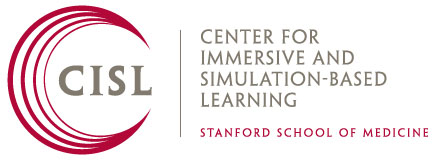CISL Mission Statement: Through CISL we improve patient safety, patient care, education, and research through innovations in immersive and simulation-based learning techniques and tools and through embedding them throughout Stanford Medical Center’s education and training programs.
 Stanford University School of Medicine and its affiliated hospitals are home to world pioneers of techniques, technologies and applications for immersive and simulation-based learning (ISL). To achieve a further integration in the application of simulation in our own system and to reap the maximum scholarly benefit offered by individual laboratories and investigators, Stanford University School of Medicine created the Center for Immersive and Simulation based Learning (CISL – pronounced “sizzle”).
Stanford University School of Medicine and its affiliated hospitals are home to world pioneers of techniques, technologies and applications for immersive and simulation-based learning (ISL). To achieve a further integration in the application of simulation in our own system and to reap the maximum scholarly benefit offered by individual laboratories and investigators, Stanford University School of Medicine created the Center for Immersive and Simulation based Learning (CISL – pronounced “sizzle”).
CISL is led by the Associate Dean for Immersive and Simulation-based Learning, Dr. David Gaba. CISL’s goal is to provide the coordination and integration of effort and link the activities of the diverse simulation facilities and experts within Stanford University Medical Center. CISL provides a single point of focus and expertise on the use of ISL techniques in health care.
In addition, CISL operates the Goodman Immersive Learning Center (ILC), a 28,000 square foot, state of the art simulation facility that serves as the hub for immersive learning activities in the medical school. ILC faculty and staff provide a wealth of resources and expertise to assist in the development of simulation-based curricula for all levels of learners.
![]() CISL Strategic Plan (dist. March 2012)
CISL Strategic Plan (dist. March 2012)
Stanford University Medical Center (SUMC) includes the School of Medicine, Stanford Hospital and Clinics, Lucile Packard Childrens Hospital, and for CISL’s activities also includes the VA Palo Alto Healthcare System
CISL Strategic Goals
- Education and Training of Students & Clinical Trainees Immersive and Simulation-based Learning (ISL) is used to improve the education and training of Stanford students (undergraduate, medical and graduate) and the Medical Center’s trainees (residents, clinical fellows and postdoctoral scholars).
- Healthcare Systems Improvement To improve care delivery and operational outcomes of Stanford Hospital and Clinics, Lucile Packard Children’s Hospital, VA Palo Alto, (and in conjunction with the SHC/LPCH Insurance Company (SUMIT)), by improving the individual and teamwork skills of healthcare personnel.
- Assessment/Testing To use ISL techniques for explicit assessment/testing of skills, knowledge, and performance of students, trainees, and experienced personnel (as distinct from assessments that are embedded in sessions conducted for “training”).
- Research To promote, support and conduct fundamental research and evaluation about ISL and to use the ISL techniques as a research tool.
- Provide ISL Learning to External Experienced Clinicians Through ISL, to improve the clinical skills (both “technical” and “non-technical”) of healthcare personnel as individuals and in teams.
- Community Outreach To develop and conduct outreach programs to expose local community and lay groups, as well as public safety and public health organizations, and healthcare providers to the benefits and potential of ISL.
- Leadership and Advocacy To provide leadership in advocating the future vision of immersive and simulation-based learning in health care for the nation and the world.
- Faculty Development To recruit, train and sustain faculty to become effective ISL educators.
- Sustainability To provide financial and program planning and analysis of ISL programs, and to support the Office of the Medical Director fundraising and ensure long-term financial viability of ISL activities.
- Management To create management infrastructures and procedures that effectively coordinates and integrate the Center’s priorities, activities and resources among its constituent units and within the School and University.


